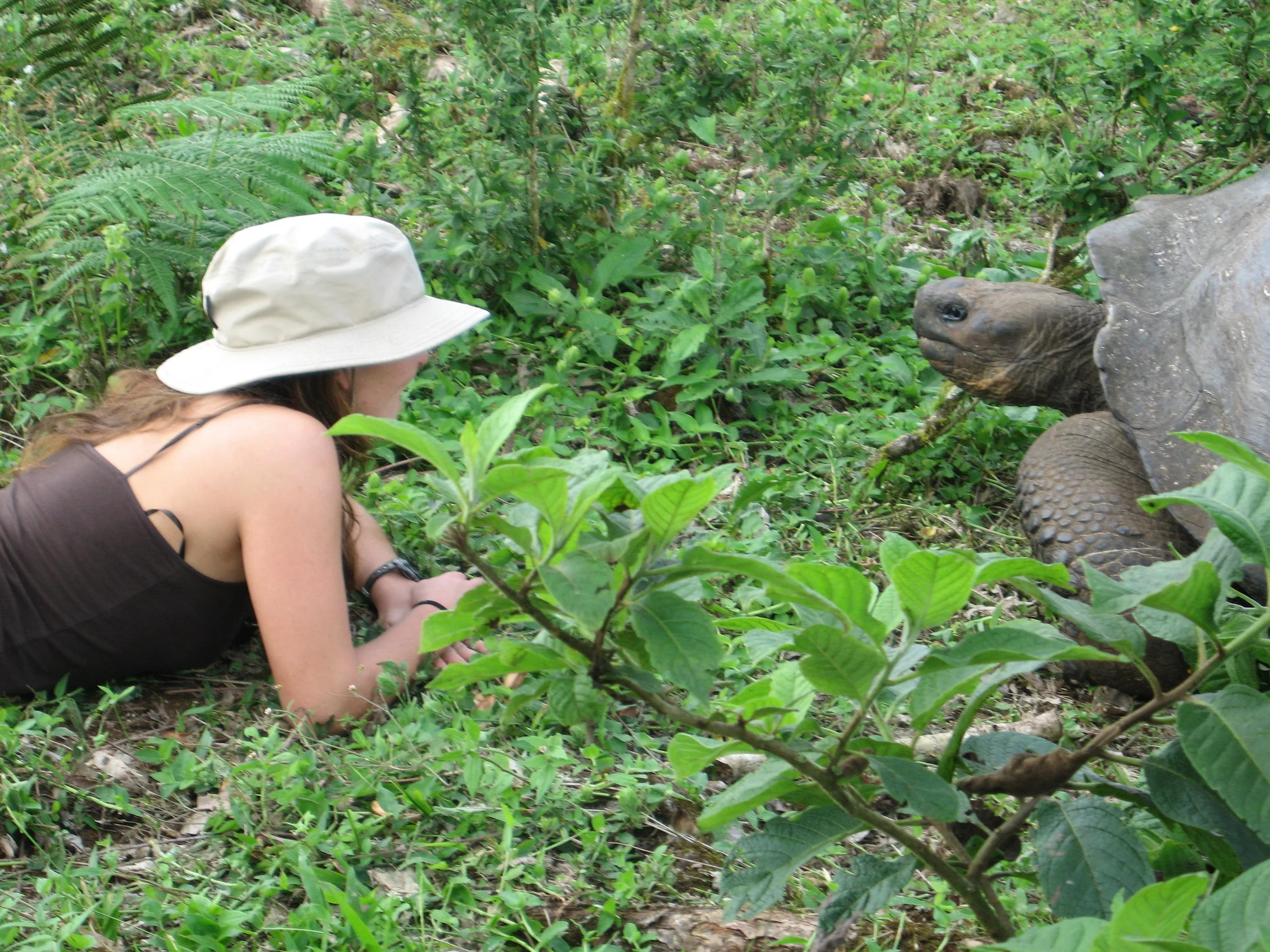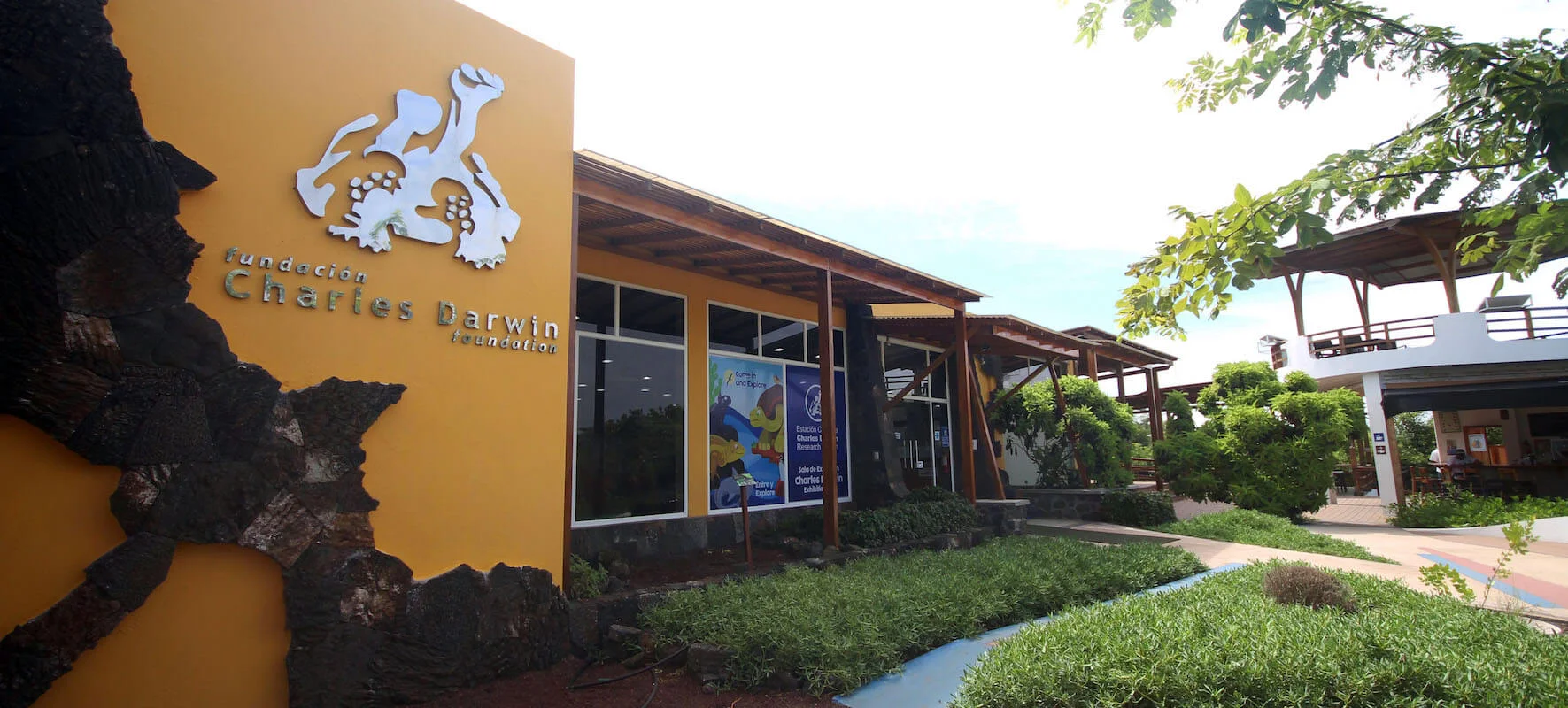
Galapagos Information
Welcome to Galápagos
The Galápagos archipelago is made up of 80 or so volcanic islands, rocks, and islets located on the equator 600 miles off the coast of Ecuador. The remote, unspoiled Galápagos Islands give travelers a glimpse of an undisturbed natural order and offer the resident wildlife a carefully protected sanctuary.
The Animals of the Galapagos Islands
Getting up close to a Galapagos Giant Tortoise
Visitors quickly become aware of the remarkable quality of the Galápagos fauna—these animals show little or no fear as you come very close. The birds don’t fly away; instead they appear interested in you. Marine iguanas sunning themselves will pay you no mind.
Why are these creatures unafraid? Because mammalian predators couldn’t survive the long sea voyages on logs or rafts needed to reach these islands. The wildlife of the Galápagos evolved without the predator threats faced by mainland species. They had nothing to fear on land at least until 1535, when man first arrived. Although the crews of pirate ships, whalers and fur sealers carried away tens of thousands of giant tortoises for food and hunted fur seals almost to extinction, only the fur seals became wary of humans. What remains is an environment unique in all the world—a truly peaceable kingdom.
A Legacy in Natural History: Charles Darwin and the Galapagos Islands
Observing Galapagos Mockingbirds
During his 1835 voyage to the Galápagos Islands, Charles Darwin and his team made groundbreaking discoveries. Upon reviewing they collections, they found that nearly half the birds and plants were unique to the islands, along with almost all the reptiles and a third of the shore fish. Even more remarkable, the species of Galápagos finches varied from island to island, sparking Darwin's curiosity. These observations in the Galápagos became the foundation for Darwin’s theory of natural selection, a concept that revolutionized our understanding of evolution, nature, and humanity.
What will I see in the Galapagos?
Charles Darwin Research Station
On all Galápagos Islands tours, you’ll visit the Charles Darwin Research Station and Galápagos National Park headquarters on the island of Santa Cruz to learn firsthand about the conservation and research efforts in the islands. There you’ll see tortoise hatchlings and learn about rearing programs that are saving several subspecies of tortoises and iguanas from extinction.
In addition to Santa Cruz, the islands you may visit during your cruise of the archipelago will vary depending on your itinerary. INTEGRITY Eastern and Western routes are almost equal in opportunity for wildlife viewing, hiking, snorkeling and kayaking. Unless there is a very specific animal you would like to see during a certain time of the year, we find that guests equally enjoy both routes. It is really hard to go wrong as both are unique in their own ways.
You will see most iconic Galápagos animals on both itineraries. These animals include giant tortoises, frigatebirds, boobies, iguanas, Galápagos Penguins, sea lions, fur seals, finches, mockingbirds, sharks, rays, sea turtles. One big difference is that only on the Eastern Route you will see Red-footed Boobies and from roughly April through November the Waved-albatross, and only on the Western Route will you see the Flightless Cormorant.
Throughout the Islands
The Galápagos Islands lie at the intersection of several major scientific disciplines; geology, volcanology, plate tectonics, ocean currents, climate patterns, and of course, wildlife and the theory of natural selection. Swim with Sea Turtles, Galápagos Penguins and sea lions, discover giant tortoises in the wild, watch hundreds of marine iguanas basking in the sun, and their much larger terrestrial cousins burrowing nests along park trails. Delight in brightly colored Sally-Lightfoot crabs, elusive ghost crabs skittering across sandy beaches, or mockingbirds curious about you. And on both routes, you'll see the iconic Blue-footed Booby, the ultimate clown prince of the Galápagos.
The Eastern Islands
Older, mostly the result of volcanic uplift, these islands are relatively flat, heavily eroded, and home to some spectacular birdlife, such as the world's only breeding site of Waved Albatross on Española Island, or masses of Red-footed Boobies and Great Frigatebirds on Genovesa Island. If you're lucky, you may even see Short-eared Owls. You’ll likely also encounter the Large-beaked Ground Finch, Large Cactus Finch, dense colonies of land iguanas, the largest giant opuntia cactus, El Junco—the fresh water lake on San Cristóbal, more opportunity to swim with penguins and see sharks while snorkeling, more nesting frigatebirds, more Swallow-tailed Gulls, more Red-Billed Tropicbirds, swarms of petrels at Genovesa and Short-eared Owls hunting them, iconic Bartolomé peak at sunset. For contrast, you’ll also walk on one of the youngest lava flows in the Islands on Santiago Island.
The Western Islands
Younger and actively volcanic, Isabela and Fernandina Islands are sole home to the unique Flightless Cormorant. You’ll walk on young lava flows and learn about plate tectonics and geological hot spots. Explore enormous lagoons, walk on white, red, and green beaches, snorkel in search of the elusive mola mola, and learn about the colorful human history of Floreana Island. No day-boat tours reach the western visitor sites. You’re likely to encounter Flamingos (3 possible sites), Mangrove Finch, Medium Tree Finch, fur seals sleeping that you can approach closely, more human history (Wittmer's Cave on Floreana, Post Office Barrel, ancient mariner graffiti, salt mine ruins), possible giant tortoises in the wild, greater variety of lava flows, younger islands, giant uplifted coral beds, more Brown Noddy Terns, higher likelihood of seeing marine iguanas feeding, more variety of beaches, higher likelihood of whales and dolphins, possible giant sunfish.
When is the best time to visit the Galapagos?
The Galapagos Islands are a year-round destination, but there are two distinct seasons, each with unique characteristics.
Planning your trip around these seasons will help you get the most out of your Galapagos adventure.
Land Iguana
Galapagos Dry Season
From June to December, southern trade winds bring the cold Humboldt Current north to the Galapagos. The water is cooler, and the garua fog is more prevalent in the islands.
Higher elevations on the larger islands receive moisture via the pervasive mist, retaining their lush green scenery. At sea level however, there is little precipitation. For this reason, June to December is generally considered the "dry season". There can still be the occasional shower, but generally blue skies prevail.
Species more prevalent in the dry season include giant tortoises, humpback whales, blue-footed boobies, cormorants, oyster catchers, lava lizards, Galapagos hawks, masked boobies, swallow-tailed gulls, sea lions, lava herons, brown noddies, and penguins.
Galapagos Warm Season
Between December and May, the Galapagos' climate is more tropical with daily rain and cloudier skies. The ocean temperature is warmer, which is ideal for swimming and snorkeling.
Species more prevalent in the warm season include marine iguanas, sea turtle, land iguanas, flamingos, white-cheeked pintails, masked boobies, marine iguanas, albatross, and blue-footed boobies. Snorkeling is will be far more enjoyable during these months.
Hood Mockingbird
Giant Tortoise
Is this the right trip for me?
Our shore landings in the Galapagos Islands include many short strolls and some longer hikes, usually over rough terrain and sometimes in hot weather. While are none are particularly strenuous, good balance and sturdy shoes will provide a distinct advantage. Obviously, the more fit you are, the more fun you will have. We encourage you to exercise regularly beforehand. If you walk, swim, bicycle, jog, or participate in aerobic workouts, your trip will be easier and more enjoyable.
If in the course of the trip however, you are concerned about your ability to do any particular hike or activity, please consult our naturalist guide before you start. We have structured our itineraries in ways that permit you to skip a planned activity if you choose.
We offer several different variation in Galapagos. Selecting the perfect trip will depend on the time you have.
9-Day Galapagos Adventure: A complete adventure in the least amount of time. You’ll spend a full 8-days in Galapagos with just a quick overnight transit stop on the mainland.
10-Day Origins of Species: Our signature adventure with two days of exploration on Santa Cruz as well as a night in the Santa Cruz highlands to ease into the Galápagos rhythm before boarding the yacht.
11-Day Islands and Highlands: Combine our Origins of Species adventure with 3 days of exploration of the Andean highlands. Enjoy a two-night stay at the luxurious and historic Hacienda Zuleta.
14-Day Galapagos and Amazon Adventure: Explore two completely different ecosystems by combing our 8-day cruise with 5 days in the Ecuadorian Amazon rainforest at a remote jungle lodge.
15-Day Andes, Amazon, and the Galapagos: Discover the breadth of Ecuador with the Andes in Quito and Otavalo, the Amazon via the ANAKONDA’s 5-day river cruise, and the Galapagos via a 6-day cruise aboard INTEGRITY.
14-Day Machu Picchu and Galapagos: Explore the best of Machu Picchu and the Sacred Valley before heading to Ecuador and the Origins of Species adventure.
17-Day Peru and Galápagos: The best of all worlds as you explore Lima, Cusco, the Incan ruins throughout the Sacred Valley and Machu Picchu before continuing to Ecuador and joining the Origins of Species adventure.






